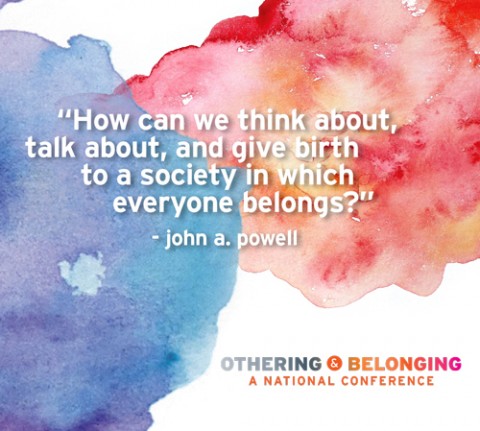Network Building as Change: Caring Through Connection
April 22, 2015 1 CommentThe following is a slightly modified post from a little over a year ago. In recent months, the notion of putting care at the center of “net work” – to ground it, make it real and people accountable – has surfaced a number of times and strengthened. The original post included the phrase “the empathic turn.” Since that time I’ve come to see “caring” as a more appropriate word, rather than “empathy,” as it evokes for me not simply feeling but action. This re-post is inspired by the activists and thought leaders who are about to gather in Oakland, CA for the “Othering and Belonging” Conference, hosted by the Haas Institute for a Fair and Inclusive Society.
In an essay that I continue to revisit, the poet/essayist/novelist/farmer/ conservationist and champion of sanity, Wendell Berry, talks about what he calls “the turn towards affection.” Having spent many years reflecting on and pushing back against the unfortunate demonstrated human capacity to despoil landscapes and demonize “the other,” he takes a strong stand for both deep rooted connection and . . . imagination:
“For humans to have a responsible relationship to the world, they must imagine their places in it. To have a place, to live and belong in a place, to live from a place without destroying it, we must imagine it. By imagination we see it illuminated by its own unique character and by our love for it.”
In other words, by his assessment, imagination thrives on contact, on an intimate form of knowing that is not simply intellectual, but intimate and holistic. For Berry it is only this kind of knowing that can lead to truly “responsible” action.
Others, past and present, hold the truth and power of this kind of fuller bodied knowing to be self-evident, in environmental conservation and social justice efforts and in what it means to be a responsible human. Professor john a. powell writes in his book Racing to Justice:
“There is a need for an alternative vision, a beloved community where being connected to the other is seen as the foundation of a healthy self, not its destruction, and where the racial other is seen not as the infinite other, but rather as the other that is always and already a part of us.”
Another call for connection, fundamental and unfettered; deeply human and humane; inter-personal and ontological. In a poignant essay about the need for racial healing, Gail Christopher of W.K. Kellogg Foundation writes,
“New laws, policies and resource-allocations are vital but not sufficient. Change must go much deeper . . . [and include] the journey towards reconnecting and re-affirming [our] individual and collective humanity.”
Imagination, justice, and responsibility thrive on contact. Believing this to be so, I often like to say that networks for social change are not simply a “so that” but an “as,” when people intentionally strive to shift (build, broaden, deepen, open, dynamize) connections. Perhaps from a strategic mindset some reach out to connect for the sake of building movement of a mass organizing kind, to reach “that goal.” This is all good, unless the ground of individual and collective being and understanding remains static and counter to efforts to alter structural and systemic realities. As the poet Marge Piercy puts it:
“If what we change does not change us, we are playing with blocks.”
And in social change work one is not generally playing with blocks, but working with life, lives, and livelihoods. So it seems that it would serve aspiring networks-as-change to make the turn towards affection, to fundamentally ground in engaged caring.
This notion is perhaps not so outlandish and squishy for some as it might have been even just a few years ago. More people seem to be sensing that the modern industrial pursuits of objectivity, detachment and standardization are not serving anyone for the long haul. Carol Sanford, in The Responsible Business, puts it this way:
“The challenge is to replace practices that distance and disconnect with ones that evoke empathy, caring, and creativity. . . . It is difficult to experience caring for other beings without connecting to them directly and seeking a deep understanding of their uniqueness.”
Caring is good business practice, according to Carol, because it can keep organizations and enterprises from being overly self-referential, “more concerned with stated goals than with living realities.” And it seems that more people, and perhaps especially those with considerable privilege and certain kinds of power, need to tune into living realities and the larger living systems of which we are all a part.
So what does it mean to embrace caring in networks-as-change? A few thoughts here and curious to hear any additions and/or reactions:
- Go beyond abstraction to interaction – go to and meet in real places with real people, explore/get to know them, consider how life happens there/for them (see for example Story of Place)
- Connected to the above, cultivate practices that lead to a shared sense of inhabiting and belonging
- Embrace diversity, inclusion and equity as being fundamental to the work of any networked social change effort
- Support learning (share stories and data) around the realities of structural injustice and implicit bias
- Encourage curiosity by inviting people to interview one another about their experiences and to lead with listening and inquiry.
- Develop awareness of the “empathy gap” that can come from privilege, socioeconomic, racial, and cultural divides
- Practice mindfulness meditation or mindsight as a way of strengthening the ability to focus attention on our own and others’ experiences


1 Comment
Good sir,
Enclosed is our programme/project proposal for the upcoming ‘World Sight Day’ that will take place some time in October 2016.
Thank you for your careful perusal and favourable response.
Basil Ugbechie
c/o Cordinator
Heritage Lifebuoy Foundation
http://www.heritagelifebuoy.org